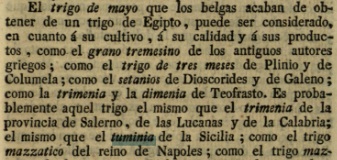For those readers who were intrigued by Jacob’s somewhat enigmatic comment on tumminia wheat, but put off by having to download a huge PDF of an 1818 edition of the Memorias de Agricoltura y Artes, in Spanish, here’s the money quote:
And here’s a quick translation:
The May wheat that the Belgians have recently obtained from an Egyptian wheat can be considered, based on its agronomy, its quality and its products, to be the same as the tremesino wheat of the ancient Greek authors; the three month wheat of Pliny and Columella; the setanio of Dioscorides and Galen; the trimenia and dimenia of Theophrastus. It is probably the trimenia of the province of Salerno, of Lucana and Calabria; the same as the tuminia of Sicily; the mazzatico wheat of the Kingdom of Naples; the mazzuolo wheat of the Tuscans.
People have been exchanging crop diversity, and been interdependent on each other for it, for a long time, I guess.
Jeremy has more on the etymology of tumminia in another comment.
